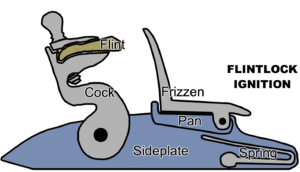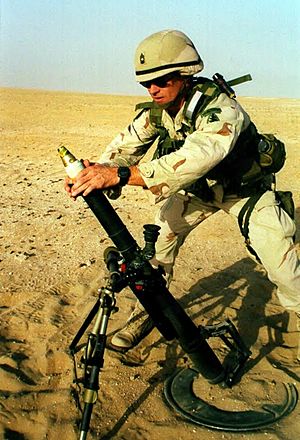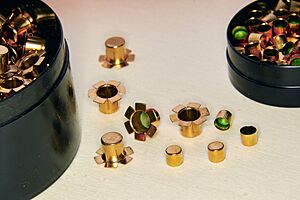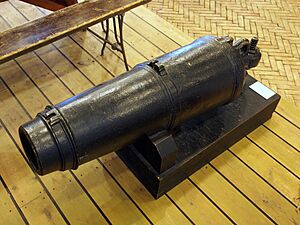Muzzleloader facts for kids

A muzzleloader is a type of firearm. With these guns, the projectile and the gunpowder are loaded from the front end of the barrel. This front end is called the muzzle. Most modern guns load from the back, which is called breech-loading.
The word "muzzleloader" can also mean the person who shoots these guns. Muzzleloaders can have a rifled barrel (with grooves inside) or a smoothbore barrel (smooth inside). They come in different sizes. Modern muzzleloaders use various ways to fire, like flintlock or percussion systems. Muzzleloaders can be anything from huge cannons to small pistols. Today, the term usually refers to black powder small arms. These guns often use loose gunpowder and a separate way to ignite it.
Contents
The History of Muzzleloaders
Some of the first muzzleloaders were called matchlocks. The matchlock was named after its firing system. It was the first invention that let a shooter hold the gun with both hands. This also allowed them to keep their eyes on the target.
Matchlock Guns
The matchlock design used a burning rope or stick, called a "match." This match was lowered into a small pan filled with gunpowder. This small amount of powder would then ignite the main charge inside the barrel. This fired the gun. Matchlocks first appeared in Europe around the year 1400.
This matchlock system was used to make muskets. Musket barrels were smooth inside. They fired round lead balls. People who used muskets were known as "musketeers." Very few pistols used this design. However, some early shotguns were matchlocks.
Wheellock Guns

Around 1509, the wheellock was the next big step for muzzleloaders. It did not need a burning match. Instead, it made a spark mechanically with a wheel. This spark ignited the gunpowder.
However, wheellocks were very expensive to make. They cost about twice as much as matchlocks. Because of this, matchlocks continued to be used for a long time.
Flintlock Guns
It took about 200 more years for a better design to appear. A Frenchman named Marin le Bourgeoys is thought to have invented the Flintlock mechanism around the 1620s. He was an artist, a crossbow maker, and a gunsmith.
From 1660 to 1840, flintlock muzzleloading rifles and pistols were used by armies everywhere. This included European and American armies. A flintlock makes a spark when a piece of flint hits steel. This spark ignites the priming powder. The design covered the priming powder until the gun was fired. This meant it usually worked even in windy or damp weather.
In 1722, the British Army asked for a standard flintlock musket. This model and its versions were called the Brown Bess. It was used until the 1830s.
Percussion Cap Guns
The percussion cap system was the next major improvement in firearms. It was also called a caplock. The percussion cap was based on the discovery of fulminate of mercury around 1800. This chemical explodes when hit sharply.
In 1816, Joshua Shaw, an artist in Philadelphia, painted fulminate of mercury inside small copper caps. He placed these caps over a small metal cone on the gun. When the hammer hit the percussion cap, the gun fired. By 1826, percussion caps were widely used. They quickly replaced the flintlock system.
The percussion cap removed the need for a flash pan, flint, and frizzen. It did add the step of placing a cap on the cone. But it was a big advantage for soldiers in battle. Percussion caps were fast to load. They also worked in almost all weather conditions.
In 1869, the centerfire cartridge was invented. This new type of ammunition worked only in breech-loading weapons. Together, breech-loading guns and cartridges quickly replaced muzzleloaders for common use.
Mortars: Modern Muzzleloaders?

Modern mortars fire a shell. The shell has its own propelling charge and primer attached to its base. Unlike older mortars, which were loaded like cannons, modern mortars are fired by dropping the shell down the barrel. A pin at the bottom of the barrel hits the primer. This ignites the main charge, firing the shell.
Both modern and older mortars are used for high angle fire. Since the modern mortar shell is loaded in one piece, some people debate if it's truly a muzzleloader. However, it is loaded from the muzzle end, so it fits the basic definition.
Cannons: Big Muzzleloaders
Simple muzzleloading cannons existed in China from about the 12th century. One of the first cannons used in Europe was the bombard. These were muzzleloaders with different sized barrels. They could fire anything from small rocks to large cast iron balls.
By the 16th century, muzzleloading cannons began to replace bombards. Metal casting greatly improved in Europe after 1570. In the early 1500s, French cannons were used to break up groups of soldiers in their wars in Italy. The Germans had some of the best gunners in Europe. They developed cannons that could hit targets up to 1,500 yards (1,400 m) away.
Later, the Swedish army under Gustavus Adolphus developed lightweight cannons. These cannons could easily move around the battlefield. He used a cast 4-pounder cannon that weighed about 4 pounds (1.8 kg). It could be pulled by just two horses.
In 1742, Englishman Benjamin Robins wrote a book called New Principles of Gunnery. In this book, he added science to the study of ballistics (how projectiles fly). He developed carronades. These were short, lightweight muzzleloading smoothbore cannons. They were often used on the decks of ships. During the American Revolutionary War, the British had many different cannons and mortars. Many American weapons were captured British cannons.
In 1853, France introduced the Canon-obusier de 12. This was a 12-pounder cannon that could fire both solid shot and explosive shells. It was also called a "Napoleon." The U.S. Army adopted the Napoleon 12-pounder in 1857. It became the most popular field gun for both sides during the American Civil War. After the Civil War, breech-loading cannons eventually replaced muzzleloaders.
Images for kids
-
Wadding recovered from the wreck of the packet ship Hanover and was found inside a loaded cannon, National Maritime Museum Cornwall (2014)
-
Varsity Scouts of the Boy Scouts of America learning about muzzleloading rifles
See also
 In Spanish: Avancarga para niños
In Spanish: Avancarga para niños






